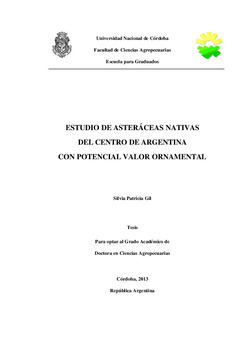| dc.contributor.advisor | Cerana, María Micaela | |
| dc.contributor.author | Gil, Silvia Patricia | |
| dc.date.accessioned | 2015-02-27T18:05:56Z | |
| dc.date.available | 2015-02-27T18:05:56Z | |
| dc.date.issued | 2013 | |
| dc.identifier.uri | http://hdl.handle.net/11086/1724 | |
| dc.description | Tesis (Doctora en Ciencias Agropecuarias)--UNC- Facultad de Ciencias Agropecuarias, 2013. | es |
| dc.description.abstract | Los objetivos de este trabajo fueron: 1) estudiar los aspectos morfológicos, anatómicos,
fenológicos y reproductivos de Bidens laevis, Viguiera tucumanensis var. tucumanensis y
Zexmenia buphthalmiflora, Asteráceas nativas de la zona central de Argentina,
seleccionadas por su potencial valor ornamental; 2) revalorizar el germoplasma nativo y
propender a su preservación. Se describieron las características morfoanatómicas, las
estructuras reproductivas y el desarrollo de las plántulas. Si bien presentan caracteres
comunes a la familia, cada especie ha desarrollado estrategias para adaptarse al medio en
que crece. Bidens laevis tiene aerénquima en los tres órganos de la planta y menos estomas
por su vida acuática. Viguiera tucumanensis posee mayor frecuencia de estomas y
complejos estomáticos grandes y Z. buphthalmiflora tiene más cantidad de tricomas por
mm2; ambas especies poseen cutículas gruesas, pilosidad abundante, mesofilos
equifaciales, bajos índices de vulnerabilidad, tallos con endodermis y xilopodios, entre
otras características xeromórficas. Las tres especies se deslucen en la época invernal,
siendo Z. buphthalmiflora la que presenta el mayor período de floración. Bidens laevis se
destaca por su belleza a fines de verano y en otoño y V. tucumanensis en otoño. Coexisten
en ellas dos formas de reproducción sexual, autogamia espontánea y alogamia. Desde el punto
de vista de la polinización son entomófilas generalistas. Existe autopolinización, pero es
menos eficiente que la polinización cruzada. Las tres especies son aptas para el cultivo a
partir de semillas, aunque con el paso del tiempo la viabilidad de éstas disminuye. En B.
laevis los esquejes de tallo o la división de mata son las formas más eficientes de
multiplicación vegetativa, mientras que las otras especies se multiplican por esquejes de
tallo. Los especialistas en jardinería consideran que V. tucumanensis y Z. buphthalmiflora
pueden emplearse en xerojardinería y B. laevis en estanques o sectores húmedos. Las
personas de edades comprendidas entre 30-60 años, con estudios terciarios y universitarios,
consideran con buen potencial ornamental a estas tres especies. | es |
| dc.description.abstract | The goals of this Thesis were 1) to study morphological, anatomical, phenological and reproductive aspects of Bidens laevis, Viguiera tucumanensis var. tucumanensis and Zexmenia buphthalmiflora, native species of Asteraceae, from the central region of Argentine, chosen by the ornamental potential value; 2) to increase the valuation of the native germplasm and to preserve it. The morphological, anatomical, phenological and reproductive characteristics were described. Although the species have common characters to the family, each one develops strategies to be better adapted to the environment. Bidens laevis has aerenchyma in their vegetative organs and less stomata because of their aquatic life. Viguiera tucumanensis has the highest stomata frequency and the biggest stomata complex and Z. buphthalmiflora has the highest number of trichomes by mm2; both species have thick cuticles, high trichome density, equifacial mesophylls, low vulnerability index, endoderm in stems and xilopodes, between other xeromorphic characteristics. The three species become ugly in winter. Zexmenia buphthalmiflora has the longest flowering period. Bidens laevis has the greater beauty at the end of winter and in autumn, and V. tucumanensis in fall. They have two sexual reproduction forms, spontaneous autogamy and allogamy. The cross-pollination is entomophily, the species are visited by different insects. Although self-pollination occurs, it’s less efficient than cross-pollination. The three species can be cultivated from seeds, but they lose viability along the time. In B. laevis the stem cuttings or mass division are the best ways of vegetative propagation, the others species could be reproduced by stem cuttings. Landscapers consider that V. tucumanensis and Z. buphthalmiflora can be used in xeriscape and B. laevis in aquatic gardens or humid zones. People, between 30-60 years, with high levels of studies, think that these three species have good ornamental potential. | en |
| dc.format.extent | 167 h. : ilustración color | |
| dc.language.iso | spa | es |
| dc.rights | Atribución-NoComercial-SinDerivadas 2.5 Argentina | * |
| dc.rights.uri | http://creativecommons.org/licenses/by-nc-nd/2.5/ar/ | * |
| dc.subject | Especies nativas | es |
| dc.subject | Asteraceae | es |
| dc.subject | Plantas ornamentales | es |
| dc.subject | Anatomía de la planta | es |
| dc.subject | Fenología | es |
| dc.subject | Reproducción sexual | es |
| dc.subject | Etapas de desarrollo de la planta | es |
| dc.title | Estudio de asteráceas nativas del centro de Argentina con potencial valor ornamental | es |
| dc.type | doctoralThesis | es |





